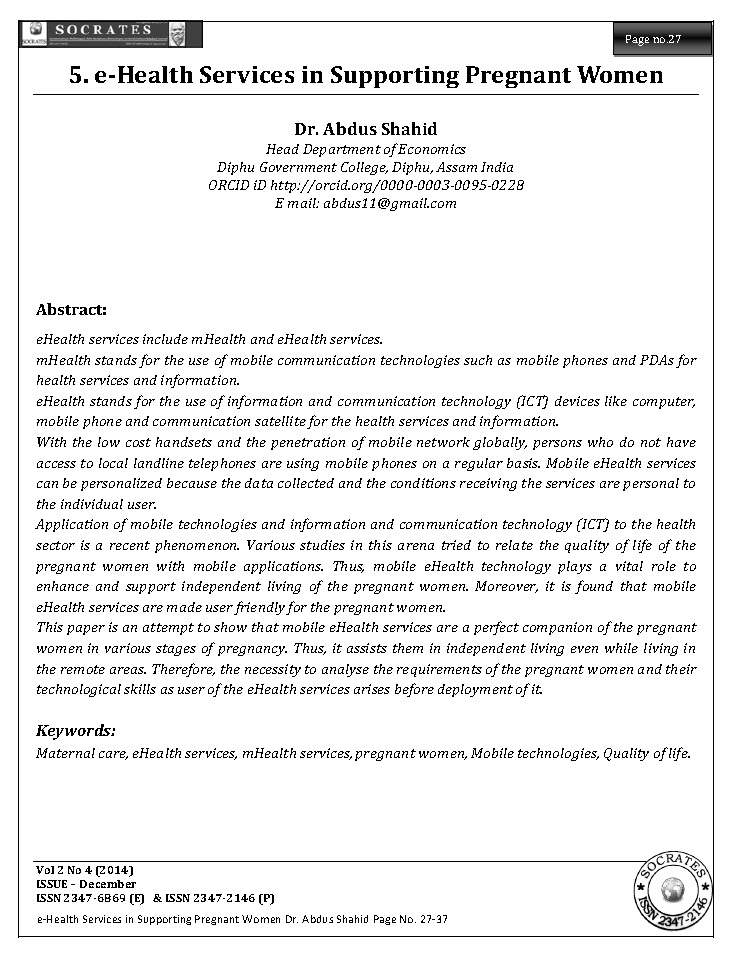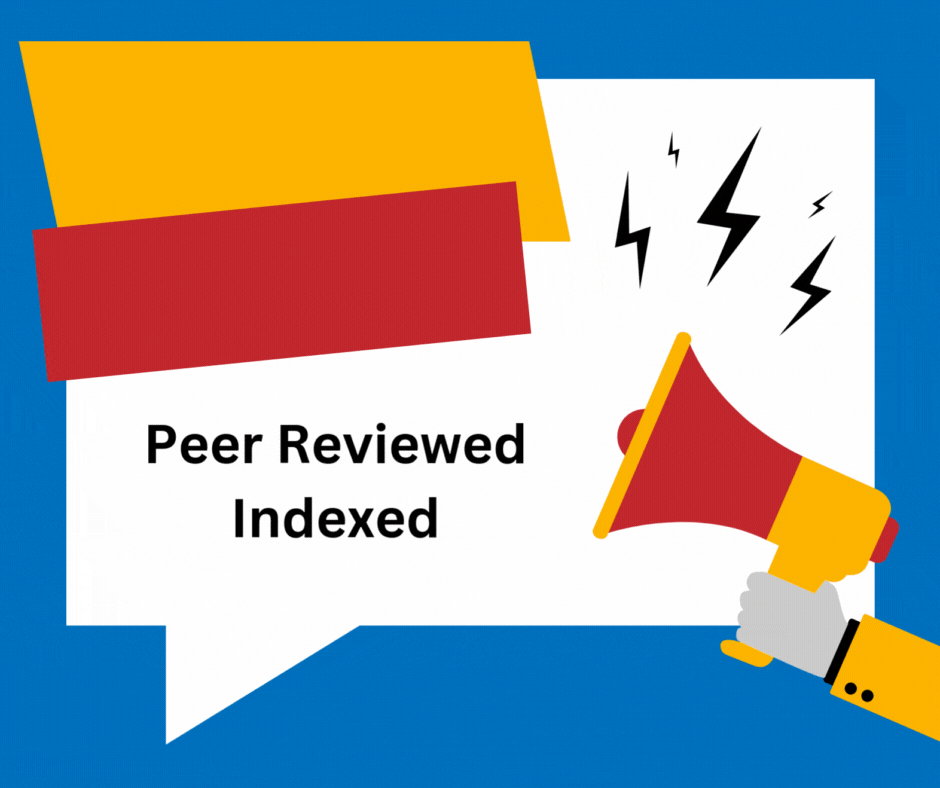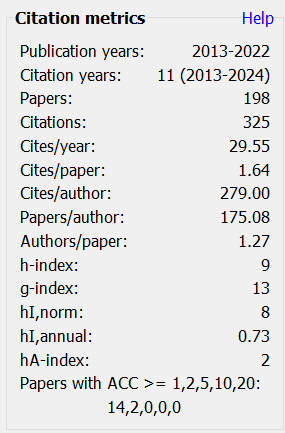e-Health Services in Supporting Pregnant Women
Keywords:
Maternal care, eHealth services, mHealth services, pregnant women, Mobile technologies, Quality of lifeAbstract
eHealth services include mHealth and eHealth services. mHealth stands for the use of mobile communication technologies such as mobile phones and PDAs for health services and information. eHealth stands for the use of information and communication technology (ICT) devices like computer, mobile phone and communication satellite for the health services and information. With the low cost handsets and the penetration of mobile network globally, persons who do not have access to local landline telephones are using mobile phones on a regular basis. Mobile eHealth services can be personalized because the data collected and the conditions receiving the services are personal to the individual user. Application of mobile technologies and information and communication technology (ICT) to the health sector is a recent phenomenon. Various studies in this arena tried to relate the quality of life of the pregnant women with mobile applications. Thus, mobile eHealth technology plays a vital role to enhance and support independent living of the pregnant women. Moreover, it is found that mobile eHealth services are made user friendly for the pregnant women. This paper is an attempt to show that mobile eHealth services are a perfect companion of the pregnant women in various stages of pregnancy. Thus, it assists them in independent living even while living in the remote areas. Therefore, the necessity to analyse the requirements of the pregnant women and their technological skills as user of the eHealth services arises before deployment of it.
Downloads
Metrics
References
Babycenter, expert advice, (2014), “health problems in pregnancy”,www.babycenter.com
Carers watch, (2014), “find me”. Www.carerswatch.com.au
Center for health market innovations (chmi), (2010), gliconline,http://healthmarketinnovations.org
Center for health market innovations (chmi), (2010), operation asha. Washington:http://healthmarketinnovations.org
Center for health market innovations (chmi), (2010), rapidsms, malawi. Washington:http://healthmarketinnovations.org
Down, p., (2009), “introduction to videoconferencing”, https://www.ja.net
Eysenbach, g. & diepgen t, (1998), “responses to unsolicited patient email requests formedical advice on the world wide web”, the journal of the american medicalassociation., 280,1333-1335
Frimley park hospital, nhs foundation trust (nhs), (2005), “what is antenatal care?”,www.frimleypark.nhs.uk
Ibgstar, (2014), “blood glucose basics”, www.ibgstar.us
Ihealthlabs, (2014), “wireless blood pressure monitor”, www.ihealthlabs.com
Indexmundi, (2011), “historical data graphs per year”, www.indexmundi.com
Jacaranda health, (2011), “medical records and mobile phones for maternal health. Clinical innovations, technology for maternal health”, http://jacarandahealth.org
Kanjo, e., (2007), “mobile phone as sensors”, university of cambridge horizen seminar,www.admin.cam.ac.uk
Mobile alliance for maternal action (mama), (2011), “the power of health in everymamas hand”, www.mobilemamaalliance.org
Mosio, (2014), healthcare communication services, www.mosio.com
Pti (press trust of india), (2014), “india to soon get 'e-healthcare service”, august 12
Romano, a. M., (2007), “a changing landscape: implications of pregnant women.Internet use for childbirth educators”, j perinat educ v.16(4):18-24,
Shahriyar, r., bari, m. F., kundu, g., ahamed, s. I., & akbar, m. M., (2009), “intelligentmobile health monitoring system (imhms)”, international journal of control andautomation, vol.2, no.3
United nation population fund (unfpa), (2012), “trends in maternal mortality: 1990to 2010”, who, unicef, unfpa and the world bank estimates, https://www.unfpa.org
Vidyo, (2014), “personalised healthcare without borders”, www.vidyo.com
Vital wave consulting, (2011), “mhealth for development: the opportunity of mobile technology for healthcare in the developing world”, united nations foundation,Vodafone foundation. P. 9.
Women’s and health alliance international (waha), (2014), “working together to improve women's and children’s health”, www.doccheck.com
World health organization & unicef, (2010), “countdown to 2015 decade report(2000 v2010): taking stock of maternal, newborn and child survival”, geneva & newyork, www.countdown2015mnch.org
World health organization (who), (2014), “maternal health”, www.who.int
World health organization (who), (2014), “Millenium development goals 5: improve maternal health”, www.who.int
World health organization (who), (2012), “e-health in low and middle-income countries findings from the centre of health market and innovations”, bulletin of the world health organization 2012:90:332-340, www.who.int
Zamani, z. A., (2009), “computer technology and counselling”, school of psychology and human development. Faculty of social science and humanities, ieee

Downloads
Published
How to Cite
Issue
Section
License
Revised Copyright/CC license that applies to all the articles published after 05-02-2017
Attribution-NonCommercial 4.0 International (CC BY-NC 4.0)

Copyright/CC license that applies to all the articles published before 05-02-2017
Attribution-Non Commercial-No Derivatives 4.0 International (CC BY-NC-ND 4.0)

Author(s) will retain all the right except commercial and re-publishing rights. In the case of re-publishing, they will have to obtain written permission from the journal. Additional licensing agreements (Creative Commons licenses) grants rights to readers to copy, distribute, display and perform the work as long as you give the original author(s) credit, they can not use the works for commercial purposes and are not allowed to alter, transform, or build upon the work. For any reuse or distribution, readers and users must make clear to others the license terms of this work. Any of these conditions can be waived if you get permission from the copyright holders. Nothing in this license impairs or restricts the authors’ rights. To view a copy of this license, visit http://creativecommons.org/licenses/by-nc-nd/4.0/ or send a letter to Creative Commons, 171 Second Street, Suite 300, San Francisco, California, 94105, USA.
Research Papers published in SOCRATES are licensed under an Attribution-NonCommercial-NoDerivatives 4.0 International (CC BY-NC-ND 4.0)












